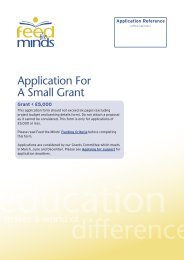Female Genital Mutilation practices in Kenya: - Feed the Minds
Female Genital Mutilation practices in Kenya: - Feed the Minds
Female Genital Mutilation practices in Kenya: - Feed the Minds
Create successful ePaper yourself
Turn your PDF publications into a flip-book with our unique Google optimized e-Paper software.
executive summary<br />
4.<br />
<strong>the</strong> WHO def<strong>in</strong>es <strong>Female</strong> <strong>Genital</strong><br />
<strong>Mutilation</strong> (FGM) as compris<strong>in</strong>g<br />
‘all procedures <strong>in</strong>volv<strong>in</strong>g partial<br />
or total removal of <strong>the</strong> external<br />
female genitalia or o<strong>the</strong>r <strong>in</strong>jury to<br />
<strong>the</strong> female genital organs for non-medical reasons’.<br />
An estimated 100 –140 million girls and women<br />
currently live with <strong>the</strong> consequences of FGM, most<br />
of whom live <strong>in</strong> 28 African countries.<br />
The ma<strong>in</strong> reasons for <strong>the</strong> cont<strong>in</strong>uation of FGM<br />
are firstly, as a rite of passage from girlhood to<br />
womanhood; a circumcised woman is considered<br />
mature, obedient and aware of her role <strong>in</strong> <strong>the</strong><br />
family and society. Secondly, FGM is perpetuated<br />
as a means of reduc<strong>in</strong>g <strong>the</strong> sexual desire of girls<br />
and women, <strong>the</strong>reby curb<strong>in</strong>g sexual activity before,<br />
and ensur<strong>in</strong>g fidelity with<strong>in</strong>, marriage.<br />
Evidence from <strong>the</strong> <strong>Kenya</strong> Demographic and Health<br />
Surveys (KDHS) shows that <strong>the</strong> overall prevalence<br />
of FGM has been decreas<strong>in</strong>g over <strong>the</strong> last decade.<br />
In 2008/9, 27% of women had undergone FGM,<br />
a decl<strong>in</strong>e from 32% <strong>in</strong> 2003 and 38% <strong>in</strong> 1998.<br />
Older women are more likely to have undergone<br />
FGM than younger women, fur<strong>the</strong>r <strong>in</strong>dicat<strong>in</strong>g <strong>the</strong><br />
prevalence is decreas<strong>in</strong>g. However, <strong>the</strong> prevalence<br />
has rema<strong>in</strong>ed highest among <strong>the</strong> Somali (97%),<br />
Kisii (96%), Kuria (96%) and <strong>the</strong> Maasai (93%),<br />
relatively low among <strong>the</strong> Kikuyu, Kamba and<br />
Turkana, and rarely practiced among <strong>the</strong> Luo and<br />
Luhya (less than 1%).<br />
In <strong>Kenya</strong>, approaches used, with vary<strong>in</strong>g degree<br />
of success, to encourage communities to abandon<br />
FGM <strong>in</strong>clude: health risk/harmful practice<br />
approaches; educat<strong>in</strong>g and provid<strong>in</strong>g alternative<br />
sources of <strong>in</strong>come to circumcisers; alternative rites<br />
of passage; address<strong>in</strong>g FGM through religion;<br />
legal and human rights; and <strong>the</strong> promotion of girls’<br />
education and empowerment programmes.<br />
This research was undertaken to better understand<br />
FGM as currently practised by <strong>the</strong> Kuria and<br />
Kisii communities. The study used a qualitative<br />
approach, <strong>in</strong>volv<strong>in</strong>g focus group discussions and<br />
<strong>in</strong>dividual <strong>in</strong>terviews to <strong>in</strong>vestigate:<br />
•• current attitudes and <strong>practices</strong> <strong>in</strong> relation<br />
to FGM among men and women;<br />
•• awareness and attitudes towards <strong>the</strong><br />
Alternative Rite of Passage (ARP);<br />
•• factors which encourage <strong>in</strong>dividuals to<br />
take decisions to abandon FGM.<br />
The research used qualitative methods, collect<strong>in</strong>g<br />
data through focus group discussions and key<br />
<strong>in</strong>formant <strong>in</strong>terviews.<br />
The f<strong>in</strong>d<strong>in</strong>gs show that FGM is still a celebrated<br />
public event among <strong>the</strong> Kuria, dictated by <strong>the</strong><br />
decrees from <strong>the</strong> Council of Elders, which decides<br />
when circumcision should take place. In Kisii, FGM<br />
is a private family affair, usually without public<br />
celebration, often <strong>in</strong> secret. In both communities,<br />
girls undergo<strong>in</strong>g FGM are given gifts and are<br />
generally considered more suitable for marriage<br />
and more socially acceptable. Uncircumcised girls<br />
and women frequently experience stigmatism,<br />
isolation and ridicule. However, <strong>the</strong>re is evidence<br />
<strong>in</strong> both Kuria and Kisii that <strong>the</strong> isolation and stigma<br />
directed towards uncircumcised girls and women<br />
is far greater for uneducated girls than for those<br />
who are educated.<br />
As reported <strong>in</strong> o<strong>the</strong>r research, <strong>the</strong>re has been a<br />
marked trend towards girls undergo<strong>in</strong>g FGM much<br />
younger, with many girls under 10 years of age.<br />
This appears to be <strong>in</strong> order to circumcise <strong>the</strong>m<br />
before <strong>the</strong>y might refuse and also <strong>in</strong> response<br />
to <strong>the</strong> illegality of FGM under The Children Act,<br />
s<strong>in</strong>ce 2001. The change to us<strong>in</strong>g medical staff to<br />
carry out <strong>the</strong> procedure is particularly evident <strong>in</strong><br />
Kisii, although parents <strong>in</strong> Kuria also expressed a<br />
preference <strong>in</strong> this direction.




